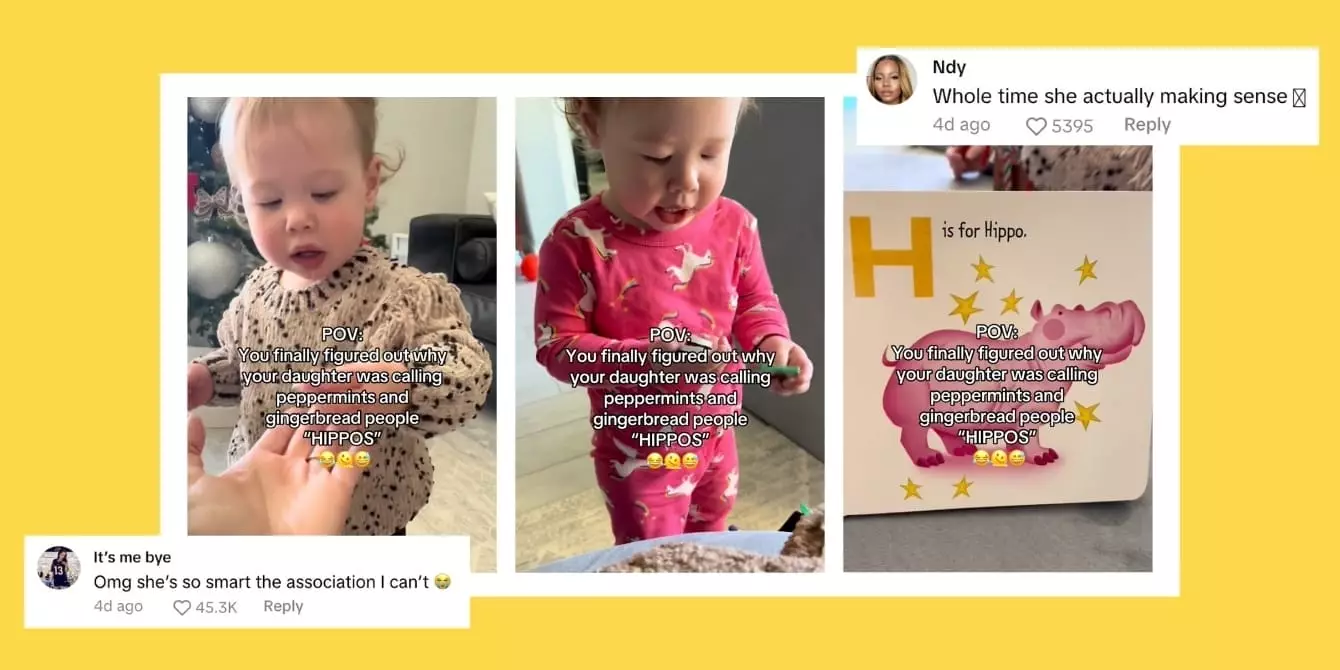Parenthood, especially during the toddler years, is a mesmerizing journey filled with unpredictable language twists and turns. Young children, with their vivid imaginations and budding vocabulary, often concoct delightful phrases that can evoke both laughter and perplexity in adults. From the enchanting way they describe everyday objects to their innocent misinterpretations, toddlers open a window into their imaginative minds, showcasing developmental milestones and unique thought processes. This article explores the delightful ways toddlers associate words and emotions, emphasizing the importance of understanding and nurturing their language development.
At around 16 months, toddlers experience significant cognitive growth, during which their brains rapidly form connections between words and the world around them. Their limited experiences and contextual understanding lead to colorful interpretations of language; for example, in a recent viral TikTok moment, a young girl referred to a peppermint candy as a “hippo.” Initially mystifying, such associations often reveal a deeper logic: the peppermint’s illustration was adjacent to a gingerbread image. This moment exemplifies the toddler mindset—grounded in context rather than rigid definitions.
The thought processes of toddlers are often linked to cognitive associations. They frequently relate objects based on the visual details surrounding them, making connections deeper than the mere labels adults might use. These cognitive leaps exemplify toddlers’ inclination to categorize experiences, meaning a dog might encompass all four-legged animals in their minds, just as a cake could elicit feelings of happiness based on previous celebrations.
Emotions and Sensory Experiences: The Building Blocks of Vocabulary
How toddlers link words to their surroundings often has roots in emotional experiences. Young children are remarkably perceptive and tend to associate new words with the emotions attached to them. For example, a child might refer to an airplane as a “bee” due to the buzzing noise it makes, seamlessly blending auditory experiences with visual identifiers. These emotional connections play a crucial role in vocabulary expansion, showcasing the intimate bond between feelings and language.
When a toddler sees a birthday cake and exclaims “happy,” they are reflecting their understanding of the celebratory context surrounding the cake, rather than employing a dictionary definition. Subsequent word associations often reflect their sensory experiences, revealing how toddlers navigate and understand their environments, emphasizing the importance of emotional context in language acquisition.
Simplifying Complexity: Phonetics in Early Language
An additional layer of language development is phonetic simplicity. As toddlers grapple with words that may prove too complex, they instinctively simplify language to accommodate their current skills. An octopus might humorously morph into “applepus,” while a backpack could become a “packpack.” These adaptations are not random but rather demonstrate toddlers’ efforts to engage with language in manageable bites.
Understanding a toddler’s unique pronunciations often requires a bit of detective work. Exploring the inspiration behind their terms and images can illuminate their thought processes. By tracing back to their experiences, asking leading questions, and engaging with their imaginative connections, parents can gain profound insights into the formative stages of their child’s language learning.
Recognizing the importance of nurturing early language skills is crucial for parents. Incorporating interactive reading into daily routines serves as a significant tool for fostering communication abilities. Pointing out objects while reading and validating their observations helps toddlers bridge the gap between words and meanings.
Furthermore, engaging children in discussions involving their emotions during storytelling enhances not only vocabulary skills but also ethical development. Routinely discussing characters’ feelings or relating interactions to their personal experiences shapes toddlers’ social awareness and empathy, contributing to well-rounded communication capabilities.
In navigating the endless humor that accompanies toddler speech, it is essential to embrace and celebrate their unique logic. Moments of whimsical wordplay, like calling Rice Krispie treats “raspberry Christmas trees,” illuminate the creativity and imaginative potential of young minds. Instead of merely correcting their playful misnomers, parents can cherish these moments as indicators of cognitive and linguistic growth.
These linguistic insights remind us that each playful miscommunication is an opportunity for growth and understanding. Parents should strive to foster these connections while maintaining an attitude of patience, curiosity, and encouragement. By celebrating their language journey, caregivers build a strong foundation for effective communication in the future.
As toddlers navigate the fascinating world of language, they not only entertain but also challenge us to appreciate the richness of their experiences. By recognizing the complexity and humor embedded within their creative expressions, we pave the way for richer communication and deeper connections. So, next time your child insists that a dog is actually a cow, take a moment to smile, celebrate their unique perspective, and relish the beautiful chaos of early childhood. What extraordinary linguistic gems have your little ones shared? We invite you to join the conversation and share your favorite toddler moments!

